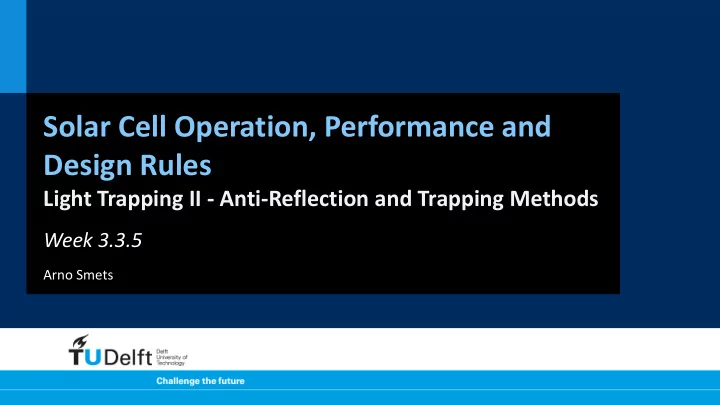

Solar Cell Operation, Performance and Design Rules Light Trapping II - Anti-Reflection and Trapping Methods Week 3.3.5 Arno Smets
Parasitic losses = outside absorbing layers 2 Al Al Reflection 2 n+ N+ p-type 4 Transmission C-Si 4 P++ P++ Al
Parasitic losses = outside absorbing layers 2 Al Al Reflection 2 n+ N+ p-type C-Si P++ P++ Al
Snell’s Law n 1 n 2 i n sin n sin 1 i 2 t t r i r
The Fresnel equation n 1 n 2 i n sin n sin 1 i 2 t t r i r
P- and S- polarization P-polarization S-polarization
Fresnel coefficients S-polarization P-polarization 2 2 n cos( ) n cos( ) n cos( ) n cos( ) 1 t 2 i R 1 i 2 t R p S n cos( ) n cos( ) n cos( ) n cos( ) 1 t 2 i 1 i 2 t T 1 R T 1 R S s p p
Reflection coefficient (n 1 < n 2 ) Brewster Angle 100 n 1 =1.0 80 n 2 =1.5 P-polarization R s , R p (%) S-polarization 60 40 20 0 0 20 40 60 80 Angle of Incidence i ( o )
Reflection coefficient (n 1 > n 2 ) 100 n 1 =1.5 Total internal 80 n 2 =1.0 P-polarization R s , R p (%) reflection S-polarization 60 40 20 0 0 20 40 60 80 Angle of Incidence i ( o )
Reflection coefficient (n 1 > n 2 ) 100 n 1 =1.5 Total internal 80 n 2 =1.0 P-polarization R s , R p (%) reflection crit = 41.8 o S-polarization 60 40 20 0 0 20 40 60 80 Angle of Incidence i ( o )
Reduction Front Reflection: n 0 n s 4 n n 2 ( n n ) 0 s T 0 s R 0 s 2 0 s n n 2 ( n n ) 0 s 0 s
Reduction Front Reflection: n 0 n s R 0 s = 0.388 T 0 s = 0.612
Rayleigh film N 0 N 1 N s First order 4 n n 4 n n 0 s approximation 0 1 T T 0 s 01 2 2 n n n n 0 s 0 1 2 ( n n ) 0 1 R 01 2 ( n n ) 0 1 2 ( n n ) 1 s R 1 s 2 ( n n ) 1 s
10 Lower reflection coeff @ 500 nm For siliconand air: 0.8 Total Reflection n n n 1 0 S 0.6 1 4 . 3 2 . 1 0.4 0.2 0.0 1.0 1.5 2.0 2.5 3.0 3.5 4.0 Refractive Index n 1 N 0 N s
N 0 =1 N s =4.3 air silicon 0 R s 0 . 388 0 T s 0 . 612 silicon Anti-reflection air N 1 =2.07 R eff 0 . 229 eff = 0.771 T
Interference:
Interference: constructive destructive Interference Interference =0 =
Interference: the anti-reflection coating Destructive interference d = 4 n E i E r1 E r2 2
Macroscopic roughness (d>> ) Path of light rays Incident light Are determined Reflected 36 By refraction. Reflected
Parasitic losses = outside absorbing layers Al Al n+ N+ p-type 4 Transmission C-Si 4 P++ P++ Al
Enhancement of Absorption path length in Thin Film Solar cells i < critical 0 i 0 i 0 i 0 i 0 i 0 i 0 i
100 80 Total internal Rs , Rp ( % ) 60 reflection 40 20 0 0 20 40 60 80 Angle of Incidence 0 i ( o )
Enhancement of Absorption path length in Thin Film Solar cells i < critical
Enhancement of Absorption path length in Thin Film Solar cells n 2 =1.5 SiO 2 n 1 =4.3 silicon SiO 2 n 2 =1.5
Enhancement of Absorption path length in Thin Film Solar cells N 2 =2.2 ZnO n 1 =4.3 silicon ZnO n 2 =2.2
Light management in solar cells L d Increasing the absorption path length
Thank you for your attention!
Enhancement absorption pathlength textured surface ` a p-type
Recommend
More recommend